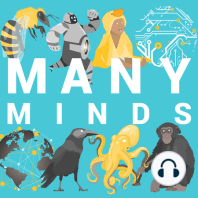81 min listen
Of molecules and memories
FromMany Minds
ratings:
Length:
75 minutes
Released:
Feb 8, 2024
Format:
Podcast episode
Description
Where do memories live in the brain? If you've ever taken a neuroscience class, you probably learned that they' re stored in our synapses, in the connections between our neurons. The basic idea is that, whenever we have an experience, the neurons involved fire together in time, and the synaptic connections between them get stronger. In this way, our memories for those experiences become minutely etched into our brains. This is what might be called the synaptic view of memory—it's the story you'll find in textbooks, and it's often treated as settled fact. But some reject this account entirely. The real storehouses of memory, they argue, lie elsewhere. My guest today is Dr. Sam Gershman. Sam is Professor of Psychology at Harvard University, and the director of the the Computational Cognitive Neuroscience Lab there. In a recent paper, he marshals a wide-ranging critique of the synaptic view. He makes a compelling case that synapses can't be the whole story—that we also have to look inside the neurons themselves. Here, Sam and I first discuss the synaptic view and the evidence that seems to support it. We then talk about some of the problems with this classic picture. We consider, for example, cases where memories survive the radical destruction of synapses; and, more provocatively, cases where memories are formed in single-celled organisms that lack synapses altogether. We talk about the dissenting view, long lurking in the margins, that intracellular molecules like RNA could be the real storage sites of memory. Finally, we talk about Sam's new account—a synthesis that posits a role for both synapses and molecules. Along the way we touch on planaria and paramecia; spike-timing dependent plasticity; the patient HM; metamorphosis, hibernation, and memory transfer; the pioneering work of Beatrice Gelber; unfairly maligned ideas; and much, much more. Before we get to it, one important announcement: Applications are now open for the 2024 Diverse Intelligences Summer Institute (or DISI)! The event will be held in beautiful, seaside St Andrews Scotland, from June 30 to July 20. If you like this show—if you like the conversations we have and the questions we ask—it's a safe bet that you'd like DISI. You can find more info at disi.org—that's disi.org. Review of applications will begin on Mar 1, so don't delay. Alright friends, on to my conversation about the biological basis of memory with Dr. Sam Gershman. Enjoy! A transcript of this episode will be available soon. Notes and links 4:00 - A general audience article on planarian memory transfer experiments and the scientist who conducted them, James V. McConnell. 8:00 - For more on Dr. Gershman’s research and general approach, see his recent book and the publications on his lab website. 9:30 - A brief video explaining long-term potentiation. An overview of “Hebbian Learning.” The phrase “neurons that fire together wire together” was, contrary to widespread misattribution, coined by Dr. Carl Shatz here. 12:30 - The webpage of Dr. Jeremy Gunawardena, Associate Professor of Systems Biology at Harvard University. A recent paper from Dr. Gunawardena’s lab on the avoidance behaviors exhibited by the single-celled organism Stentor (which vindicates some disputed, century-old findings). 14:00 - A recent paper by C. R. Gallistel describing some of his views on the biological basis of memory. 19:00 - The term “engram” refers to the physical trace of a memory. See recent reviews about the so-called search for the engram here, here, and here. 20:00 - An article on the importance of H.M. in neuroscience. 28:00 - A review about the phenomenon of spike-timing dependent plasticity. 33:00 - An article, co-authored by former guest Dr. Michael Levin, the evidence for memory persistent despite radical remodeling of brain structures. See our episode with Dr. Levin here. 35:00 - A study reporting the persistence of memories in decapitated planarians. A popular article about these fin
Released:
Feb 8, 2024
Format:
Podcast episode
Titles in the series (100)
From the archive: Clever crows and cheeky keas: A conversation with Alex Taylor by Many Minds
